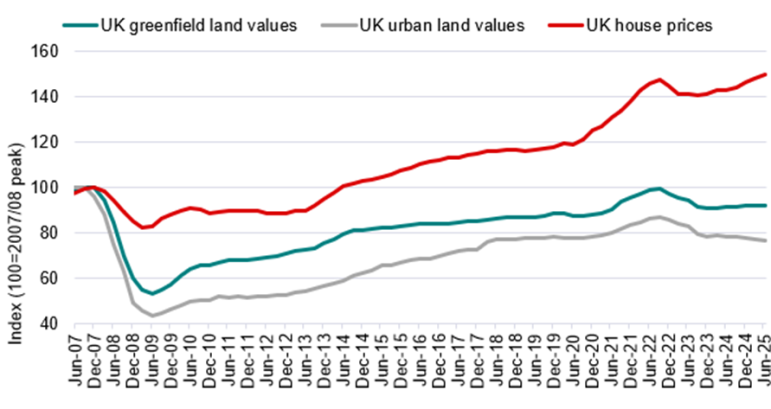Changes to national planning rules late last year have triggered an increase in sites coming to the market, according to Savills, but uncertainty around the economy and housing demand is keeping developers on the sidelines.
Savills figures show a net balance of 27% of its development agents reported more land coming up for sale in the second quarter of 2025, following revisions to the National Planning Policy Framework (NPPF) introduced in December 2024. Agents point to a greater range of sites, with some developers now able to be more selective in their acquisitions and choosing to focus on ‘oven ready’ plots in core locations.
However, this new wave of supply has yet to translate into stronger market activity. Nearly half (47%) of Savills agents reported positive market sentiment in Q2, but this is down 16 percentage points from the first quarter.
“Despite a better supplied land market in the first half of 2025, performance in the development land market has been slower than expected,” said Lydia McLaren, associate director in Savills Research. “This is largely due to ongoing economic uncertainty, cost pressures, and viability challenges.”

Sales rates for new homes have held steady at around 0.6 sales per outlet per week for the past year, with no sign of a significant improvement, according to major housebuilders.
Much of the activity is focused on strategic land, where PLC housebuilders are competing to secure future sites, particularly in so-called ‘grey belt’ locations. Larger players are prioritising applications for these strategic sites, though Savills warns that demand for grey belt land may cool as the rules and definitions become clearer.
Smaller developers, meanwhile, are sticking with existing sites and have less ability to compete for new opportunities or absorb delays.
Patrick Eve, head of UK regional development at Savills, described the land market as stable, with greenfield values flat and supply and demand “broadly aligned”. He said the government’s range of initiatives – including new funding for affordable housing, SME support, a permanent mortgage guarantee scheme and a National Housing Bank – would take time to have any impact on housing delivery.
“The impact of the upcoming increase in supply is not yet known but there is the potential for pressure on land values if there is no improvement in the housing market,” Eve said.








